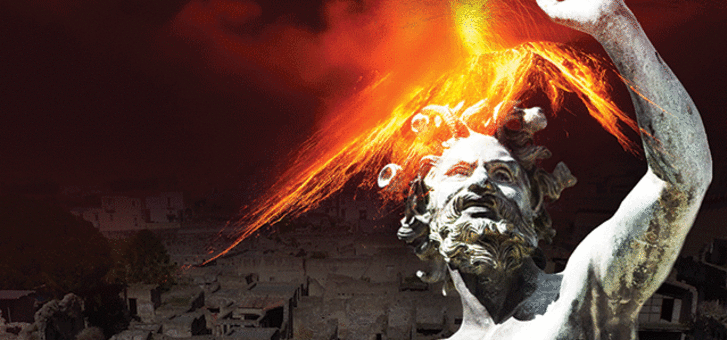They had it made. The rich built their homes there. The volcanic soil was extremely fertile and made for the very best crops. There was plenty of entertainment courtesy of the many theatres that dotted their town. The amphitheatre and the palaestra—their sports arena and training ground—were there for enjoyment and exercise. And for many, thanks to cheap slaves who did all the hard work, life was enjoyed to the full.
The warning signs were there that such a life could not go on forever, however, but nothing drastic had happened for more than 700 years, so why worry?
Fertile Soil
Almost 2000 years ago, residents living in the towns of Pompeii and Herculaneum, in what is now Italy, had lavish lifestyles and felt that life was good. After all, they had nice homes, many adorned with wall paintings and frescoes, and mosaics decorated their floors. They had plumbing, a sign of an advanced civilisation, that brought water from aqueducts right into their homes. The main street of Pompeii was called Via dell’Abbondanza, meaning “Street of Abundance.”
Pompeii and Herculaneum were two of several towns located at the foot of the volcano Vesuvius. Previous eruptions had given the area fertile soil, therefore crops grew in abundance, so the towns served as centres of trade, but were also holiday destinations for the residents of Rome, not far away.
Living in the shadow of a volcano may have created some passing concern, but according to modern volcanologists, by AD 79, Vesuvius had been inactive for hundreds of years. This would have given the inhabitants of the area a sense of security.
They developed indulgent lifestyles. Many of them spent hours each afternoon at communal public baths, a feature found in most Roman towns. Besides the obvious reason of hygiene, the baths were a social place where people could discuss business, philosophy and politics. Many public baths had under-floor heating.
Water for Pompeii originally came from wells or rainwater stored in cisterns. However, from the time of Caesar Augustus (27 BC to AD 14), an aqueduct delivered water to the city. Some 90 houses belonging to the richest residents in Pompeii were connected to the water supply and had fountains, pools and in some cases, private baths.
It is in these homes that the mosaic floors are found. One in particular, the mosaic of Alexander the Great defeating Darius of Persia, is an outstanding example of the richness of the art and decorations found in Pompeii.
|
The beautifully decorated interior of a |
The End Of The World
But the people’s lives of luxury and ease were doomed. Signs were evident that all was not well with the forces of nature. On February 5, AD 62, a powerful earthquake hit the area. Pompeii bore the brunt of this event. However, tremors were not unusual.
Beginning on August 20, 79, a prolonged series of tremors occurred over four days. However, these warnings were not recognised as harbingers of anything worse to come. The residents of the holiday resort of Herculaneum and the prosperous city of Pompeii failed to realise their time was coming to an end.
The tragic events of August 24, 79,* saw some 16,000 people die from the great eruption. A detailed account comes to us from Pliny the Younger, who was a Roman administrator and poet. The initial explosion sent a deadly cloud of stones, ash and fumes 30 kilometres into the atmosphere. This caused molten rocks and pumice to cover the area at a rate of 1.5 million tonnes per second!
Some authors describe the scenes in Pompeii and Herculaneum as “apocalyptic,” likening it to the end of the world. It’s estimated that the eruption of Vesuvius released 100,000 times more thermal energy than the atomic bomb that was dropped on Hiroshima. Then great flows of superheated gases with pumice bore down on the unfortunate towns in its path. No wonder it is regarded as one of the greatest volcanic eruptions of all time!
To add to the destruction, a minor tsunami occurred following the eruption, bringing more devastation.
The places where many of the victims died—humans and animals alike—have been found, now decomposed, so that all that’s left are empty voids within the hardened volcanic ash. More than 1000 plaster casts have been made of those who suffocated or were incinerated, capturing them in the pose of their last moments.
While a large number of residents fled with the increasing signs of volcanic activity, many stayed to their deaths, often clinging to their wealth. If only they had heeded the warning signs!
Herculaneum, Pompeii and others within the close vicinity of Vesuvius were buried and forgotten for hundreds of years.
|
A Herculaneum street with houses, |
Rediscovery
In the late 1500s, workmen who were digging an aqueduct near Pompeii discovered some marble slabs and frescoed walls, but no further excavations were made at that time.
It wasn’t until 1709 that Austria’s Prince d’Elbeuf found pieces of marble at Herculaneum. Believing he had discovered an ancient temple, he purchased the site and began excavating. This continued through the mid-eighteenth century, but was abandoned in 1748 when the nearby town of Pompeii was discovered. It was significantly easier to excavate. (Although significantly smaller than Pompeii, Herculaneum was buried under ash and pumice to a depth of 20 metres.) In 1763, an inscription was found that positively identified the site as Pompeii. Still, excavations continued only sporadically.
In 1863, excavations became more professional under Giuseppe Fiorelli, who pioneered a new system that ensured the preservation of everything that was discovered. He devised the technique of injecting plaster into spaces left by the decomposed bodies to re-create the forms of Vesuvius’s victims.
Political slogans in large letters can still be seen on some house fronts in Pompeii, although the colour is fading a little after all these centuries. At street corners and in places midway between blocks, there are large stones in the middle of the roadways. These enabled those riding in chariots to disembark onto the stones and step onto the higher footpaths, thus avoiding the debris and mud on the roadway. Another interesting insight to Roman roads is the ruts left in the stone from chariot wheels.
Because of the extraordinarily detailed insight one can get into the life of a city during Roman times, Pompeii has been a tourist destination for 250 years. Today, approximately 2.5 million people visit the site every year.
End Of The World — Again?
In the museums and other places where collections of plaster casts are kept, the tragic and sudden end of those who clung to hopes that life would continue as normal are seen repeatedly.
Today, the problems of our aged world seem to be multiplying exponentially: a lack of water in some places, typhoons in others, sea levels rising from melting of the polar ice, lowered harvest of fish due to overfishing—the list goes on.
While many may not believe in global warming or at least its cause, we can all agree that around the world, floods, earthquakes and storm destruction is happening with increasing frequency. Seasons are changing and becoming unpredictable. Add to that the unrest in people’s minds and hearts as crowds of demonstrators violently protest in many places around the world.
Refugees are growing in record numbers in Africa, Asia and Europe. If one country is not affected by war, it becomes a refuge for those fleeing the terrible conditions and unrest in another, where hundreds of thousands perish as their homes are destroyed. At times, whole towns and cities are left in ruins.
Contemplating this, some words spoken by Jesus in ancient times come to mind: “You will hear of wars and rumours of wars, but see to it that you are not alarmed. Such things must happen, but the end is still to come. Nation will rise against nation, and kingdom against kingdom. There will be famines and earthquakes in various places” (Matthew 24:6, 7).
At Pompeii and Herculaneum, we see how so many perished, their world ending on that dreadful day. But unlike these victims of Vesuvius, who perhaps did not recognise the warning signs, Jesus has told us what to look for, what the signs will be of His coming and of the end of the age.
We can dismiss the signs happening around us right now with a shrug of indifference, but it’s hard to ignore the fact that something big is about to happen.
For Pompeii and Herculaneum, their world ended on August 24, AD 79. But for those who accept God’s saving grace, Jesus’ return will not spell the end of their world, rather the beginning of something beautiful — and eternal.
* Some historians and archaeologists date the eruption of Vesuvius to November 23, AD 79.




